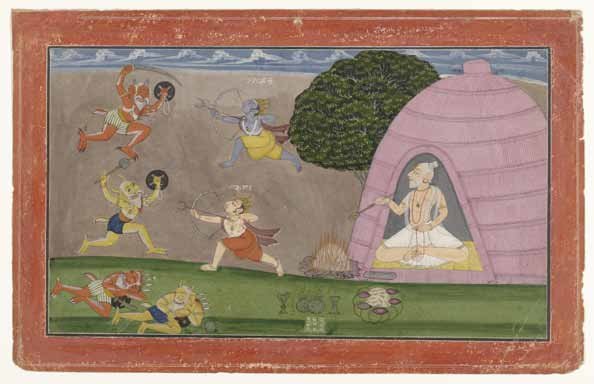The great Sage Vishvamitra taught Prince Rama, Lakshmana, Bharata, and Shatrughna; source: https://vedicfeed.com, access date: July 22, 2022.
01. Bala Kanda or The B ālakāṇḍa
First revision: July 22, 2022
Last change: Feb.04, 2023
Searched, Gathered, Rearranged, Translated, and Compiled by Apirak Kanchanakongkha.
Bala Kanda (Devanagari: बालकाण्ड, bālakāṇḍa)
The epic's first book begins with a upodghāta (อารัมภบท), "prologue," which provides a highly compressed account of the epic narrative and tells how its author came to compose the poem and, in the process, create the very genre of poetry. It also describes how the work was first transmitted and performed and provides a brief table of contents. According to this framing narrative, the sage Vālmīki, while hosting a visit from the celebrated divine seer Nārada, asks his guest if any genuinely great, heroic, and righteous man lives in their world. After a moment's thought, the seer responds with a brief, seventy-two-verse laudatory description of Rāma, including the significant events of his career and the ideological conditions that prevailed during his idyllic eleven-thousand-year reign. Although this concise and decidedly prosaic narrative makes no explicit reference to Rāma's status as an incarnation of Lord Viṣṇu, it does conclude with a brief statement of the worldly, spiritual, and heavenly rewards that accrue to anyone who reads, recites, or hears the table of the hero, an example of what is known in Sanskrit as a Phalaśruti (फलश्रुति - พลาศรุติ), "fruitful hearing," that is regularly found at the end of Hindu religious texts.
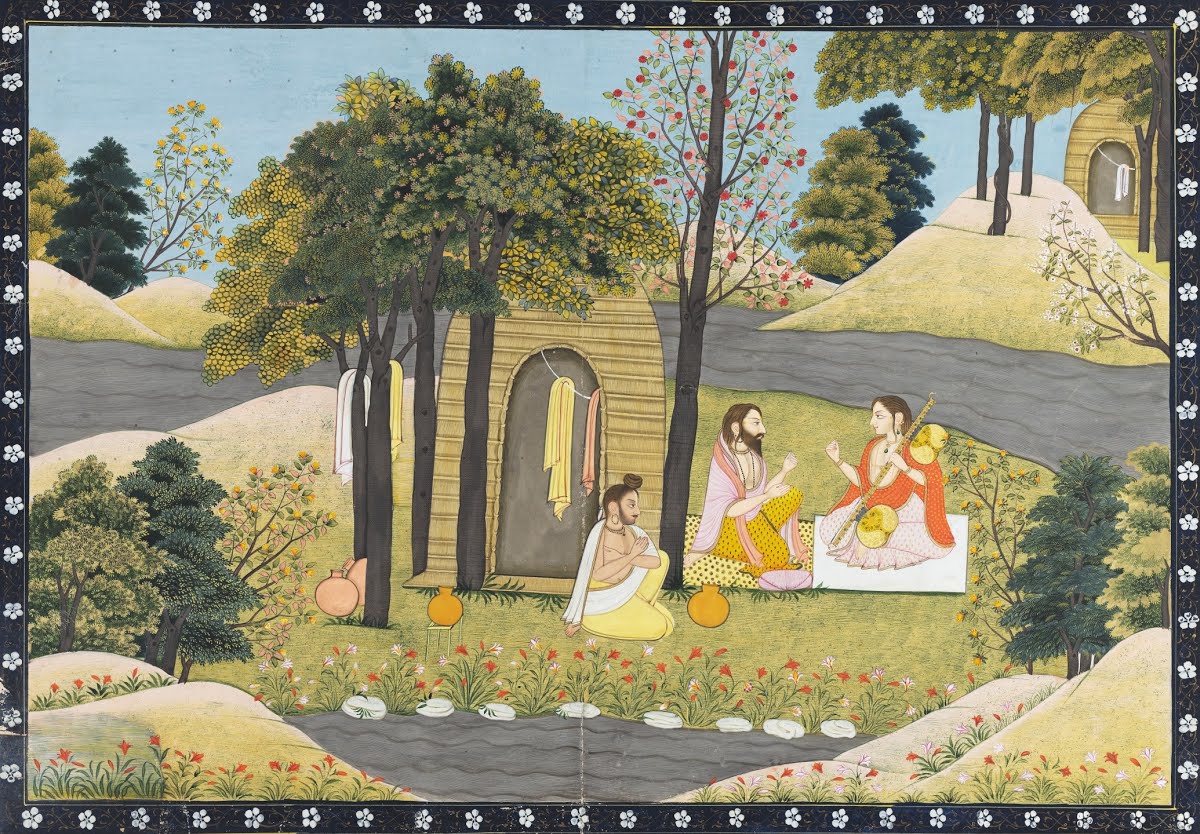 The Meeting of Sage Rishi Nārada and Sage Vālmīki, source: artandculture.google.com, access date: Aug.22, 2022.
The Meeting of Sage Rishi Nārada and Sage Vālmīki, source: artandculture.google.com, access date: Aug.22, 2022.
Following Nārada's departure, Vālmīki wanders into the woodlands to take his ritual bath. There, as he raptly watches a pair of mating sārasa cranes (นกกระเรียนขนาดใหญ่ - Sarus Crane Grus Antigone สูงประมาณ 2 เมตร ช่วงปีกยาว 2.5 เมตร นน.ประมาณ 6.8-8 กิโลกรัม), a tribal hunter emerges from the forest and kills the male bird. In access to compassion for the grieving female, the sage curses the hunter, the words pouring from his mouth in a metrical form suitable for musical rendition and accompaniment. Upon his return to his ashram, he is visited by the creator god, Lord Brahmā. The latter tells him that he had granted the sage the gifts of poetic inspiration and clairvoyance and commissioned him to compose a remarkable and moving poem about the life of Rāma, greatly expanding upon the concise version of it he had heard from Nārada. Vālmīki teaches the poem to his discipline, the twin sons of Rāma and Sītā, and the boys, acting as bards, sing it on the highways and byways of the region until, at last, they perform it before their father, King Rāma, who recognizes them as his long-lost sons and heirs.
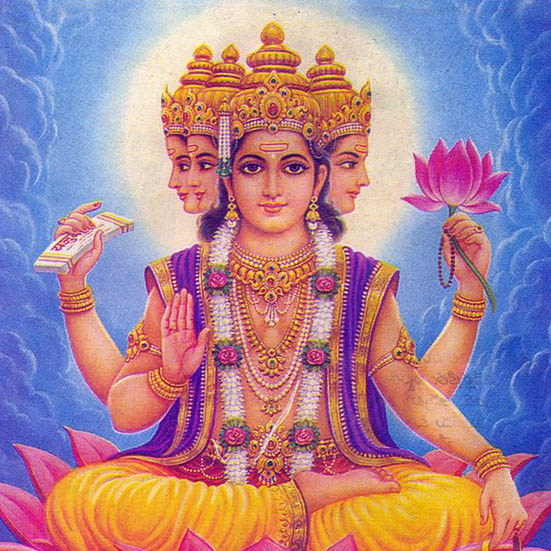
Lord Brahmā, source: dhamma.mthai.com, access date: Aug.24, 2022.
“ As long as there are mountains and as long as there are rivers on this earth, till such a time, this Rāmāyaṇa account will circulate in the worlds. As long as Rāma’s account, composed by you, circulates, till that time, you will reside in the upper regions, the nether regions, and even in my world.’ Having spoken these words, the illustrious Brahmā vanished.”
Brahmā to Vālmīki, Sarga (2), Bala Kāṇḍa.
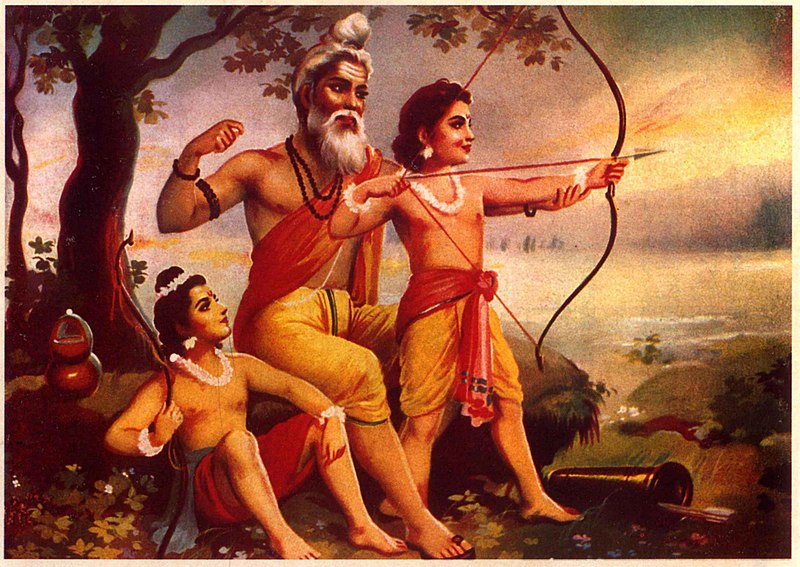
Sage Vālmīki teaches Lava and Kusha to shoot arrows, source: th.wikipedia.org, access date: Aug.25, 2022.
The epic story proper begins in the fifth sarga (สรรคที่ห้า) of the Kāṇḍa. It tells us of the mighty and prosperous kingdom of Kosala, whose king, the wise and powerful Daśaratha (ท้าวทศรถ - Daśa = ten, ทศ, สิบ; Ratha = chariot, รถ), rules from the beautiful and impregnable city of Ayodhyā. The king possesses all a man could desire except a son and heir. On the advice of his ministers and with the somewhat obscure intervention of the legendary sage Ṛśyaśṛñga (ฤษียศฤญกะ), the king performs a pair of sacrifices, as a consequence of which four splendid sons are born to him by his three principal wives. These sons Rāma (พระราม-นารายณ์อวตาร), Bharata (พระภรต บ้างก็เรียก พระพรต-จักร), Lakṣmaṇa (พระลักษมณ์-สังข์และบัลลังก์นาค), and Śatrughna (พระศัตรุฆน์ บ้างก็เรียก พระสัตรุต-คทา), we are given to understand, are infused with varying portions of the essence of the Supreme Lord Viṣṇu, who, in response to a plea from the gods, has agreed to be born as a man to destroy a violent and otherwise invincible demon, the mighty king of the rākṣasas (รากษส-รากสด), Rāvaṇa (ท้าวราวณะ หรือ ราวณะ หรือ ราพณ์ หรือ ราวัน ในรามเกียรติ์ของไทย เรียก ทศกัณฐ์ หรือ ท้าวทศกัณฐ์). To assist him in this vital mission, the Vedic gods also incarnate themselves as mighty monkeys gifted with human speech who can take on any form. The mighty ten-headed rākṣasa has long been oppressing and assaulting the gods and holy sages with impunity, for he is invulnerable to all supernatural beings by a boon that he has received through his austerities from Lord Brahmā. This last point is critical to our understanding of Vālmīki's of the Rāma story. It is why, unlike in many later, more floridly devotional versions of the tale, Viṣṇu must not only take on the appearance of a man to accomplish his mission but also remain essentially ignorant of his own true, divine nature so as not to violate Brahmā's boon.
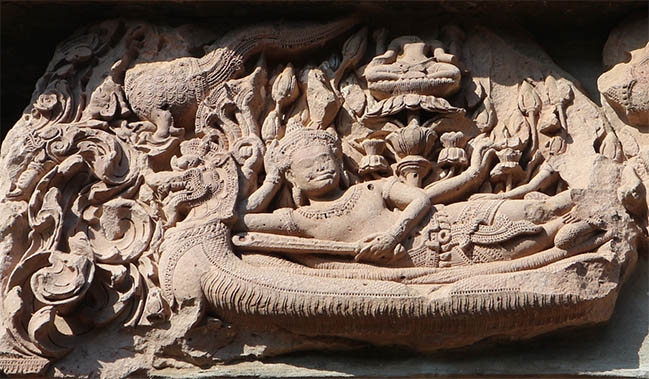 The Lintel of Viṣhṇu (Viṣhṇu Ananta Shayana Padmanabha or Phra Narai - in Thai) is asleep in the cosmic ocean (Milk Ocean - Kshirasagara) on the back of a great serpent deity known as a Naga (The Serpent Shesha or Ananta Shesha). From his navel sprouts a lotus with one thousand petals. In the middle of the lotus sits Brahmā, the creator at Phnom Rung Sanctuary, Buriram Province, Thailand, who took a picture on November 22, 2020.
The Lintel of Viṣhṇu (Viṣhṇu Ananta Shayana Padmanabha or Phra Narai - in Thai) is asleep in the cosmic ocean (Milk Ocean - Kshirasagara) on the back of a great serpent deity known as a Naga (The Serpent Shesha or Ananta Shesha). From his navel sprouts a lotus with one thousand petals. In the middle of the lotus sits Brahmā, the creator at Phnom Rung Sanctuary, Buriram Province, Thailand, who took a picture on November 22, 2020.
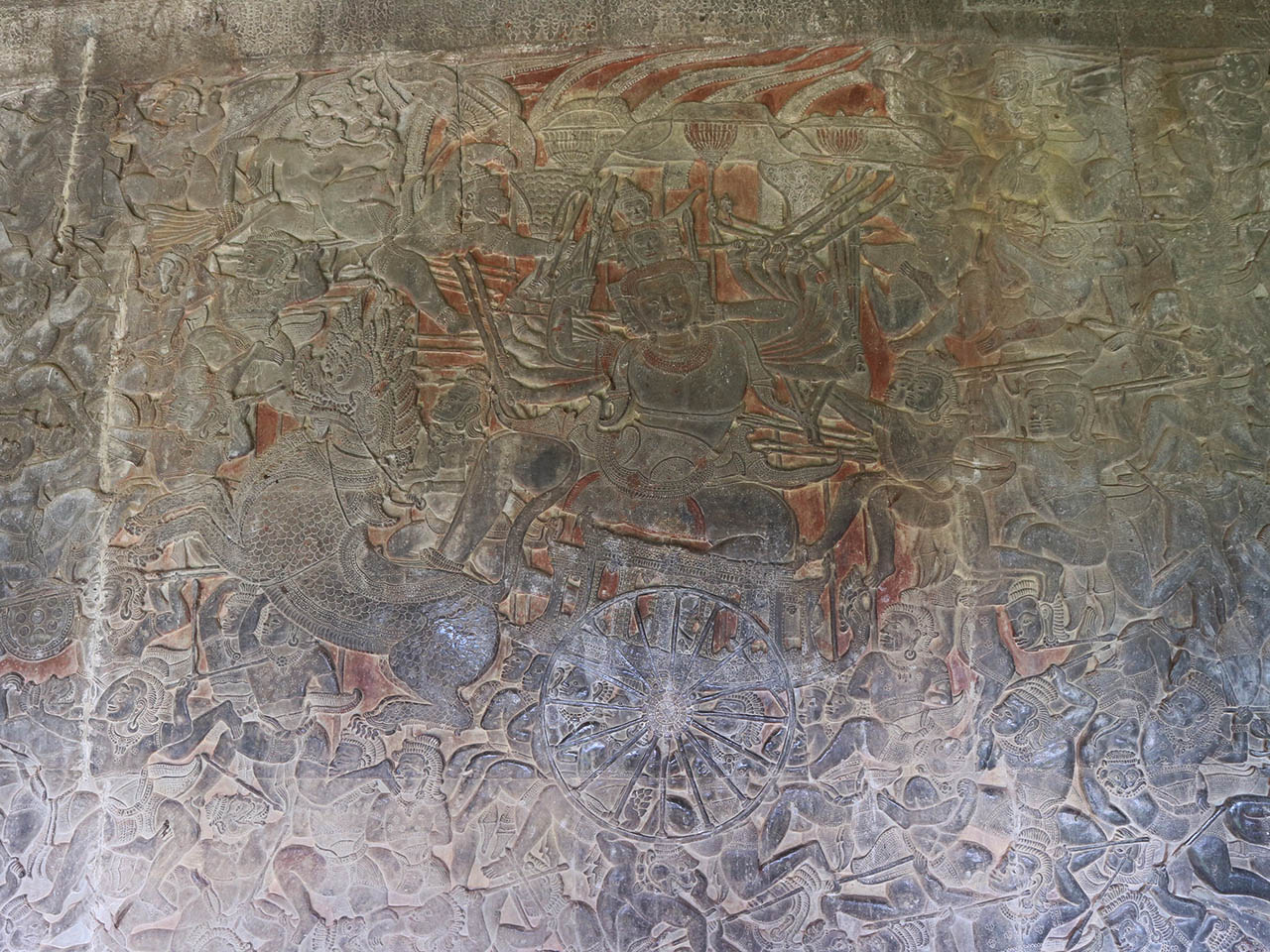 Rāvaṇa Standing on the Chariot, North-West Corridor of Angkor Wat, Siem Reap, Cambodia, took a picture on October 20, 2018.
Rāvaṇa Standing on the Chariot, North-West Corridor of Angkor Wat, Siem Reap, Cambodia, took a picture on October 20, 2018.
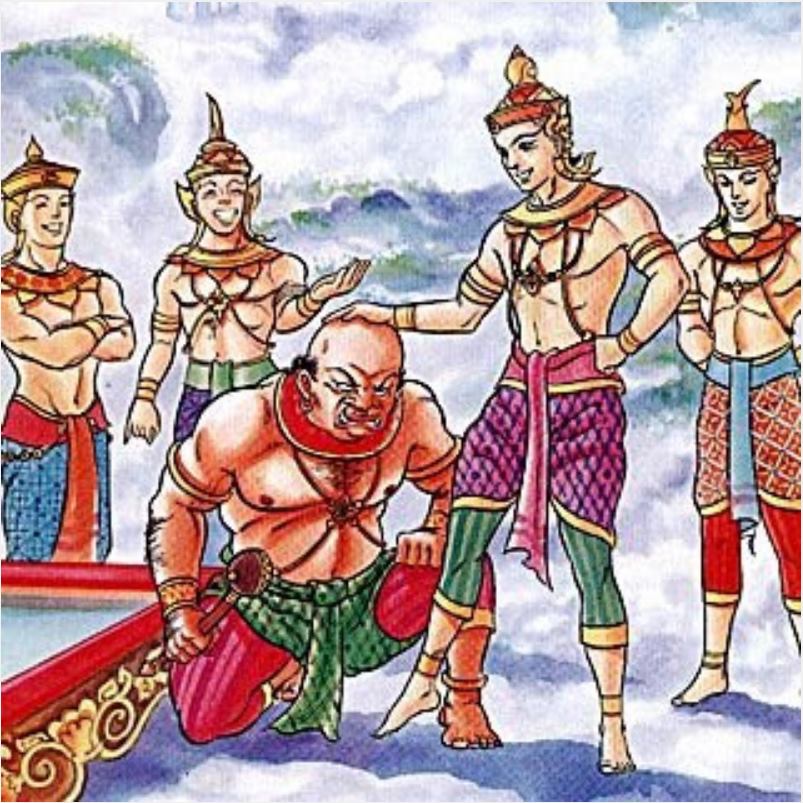 Bhasmāsura Praveen01.(Thai pronounced: Nontok) was bulled by the Devas, source: www.area.co.th, access date: Sep.23, 2022.
Bhasmāsura Praveen01.(Thai pronounced: Nontok) was bulled by the Devas, source: www.area.co.th, access date: Sep.23, 2022.
Note to expand:
01. Rāvaṇa in former life called Bhasmāsura Praveen (Nontok in Ramkien, Thai version) (Sanskrit: भस्मासुर, Bhasmāsura Praveen) committed an offense against Lord Shiva cursed to become a giant (or rākṣas ) to wash the feet of the Devas at the foot of the Kailāsa Mount stairs for many million years. being shaken by the Devas, pulling his head, bullying him his head is bald, Nontok was blessed by Lord Shiva and be blessed with a diamond finger pointing to anyone who must die, which caused trouble for the Devas, Viṣhṇu or Narai was commanded by Lord Shiva, come to fix him and defeat him by transforming into an Apsara called Mohini, she danced for Nontok to follow her and pointed his finger at himself until he died. Before Nontok's death, he lamented that Viṣhṇu had more power than he would have won. Viṣhṇu then told Nontok to be reborn with ten heads and twenty arms. Come and fight with Viṣhṇu, who is an ordinary person on Earth. This is the origin of Rāvaṇa and Rāma in the Rāmāyaṇa.
Daśaratha's sons pass a pleasant and uneventful childhood, which the poet glosses over in brief couplets. There, we learn that the four brothers divide themselves into two pairs, the foremost being Rāma and Lakṣmaṇa, with Bharata and Śatrughna forming a somewhat secondary pair. In each pair, the older brother is dominant while the younger functions mainly as a sort of esquire, as it were, to his elder.
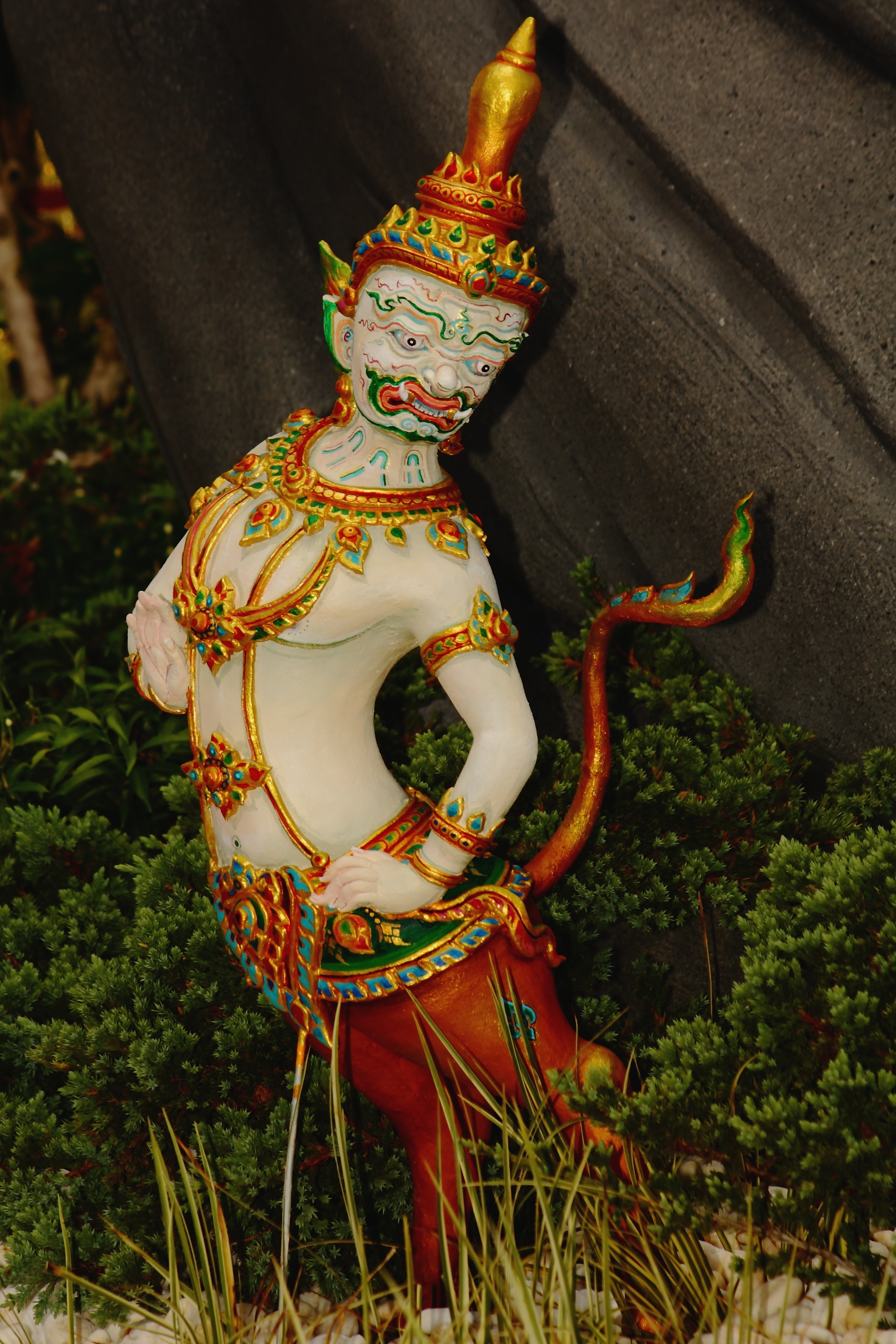 Māricā (in the accessory of crematorium Princess Phetcharat at the Pramane Ground in April 2012, Bangkok, Thailand), source: th.wikipedia.org, access date: October 6, 2022.
Māricā (in the accessory of crematorium Princess Phetcharat at the Pramane Ground in April 2012, Bangkok, Thailand), source: th.wikipedia.org, access date: October 6, 2022.
Rāma and Lakṣmaṇa fight Māricā and Subāhu, painting on paper, h. 176 x w. 276 mm, India, ca. 1750-1775, Rijksmuseum Amsterdam, source: www.researchgate.net, access date: Oct.06, 2022.
One day, however, when the princes are still mere adolescents, the powerful and irascible sage Viśvāmitra arrives at court and asks the king to lend him his eldest and favorite son, Rāma, for the task of destroying a pair of demons, the rākṣasas (รากษส) Māricā (มารีศ หรือ ม้ารีด) and Subāhu (สวาหุ - พี่ชายของมารีศ). They have been harassing his ashram and disrupting his Vedic sacrifices. With great reluctance and only out of fear of the sage's curse, the doting king permits Rāma to go. Then, accompanied by the sage and his inseparable companion, his younger brother Lakṣmaṇa, the prince sets out for the sage's ashram. Their journey: On the trip, Rāma is told – in response to his questions – several stories from Indian mythology associated with the sites through which the party passes. At one point, on the orders of the sage, Rāma somewhat hesitantly kills a terrifying rākṣasa woman (rākṣasī) named Tāṭakā (ตาฏะกา) and, as a reward for his bravery, receives from the sage a set of supernatural weapon-spells. At last, the princes reach the hermitage of Viśvāmitra, where, with his newly acquired weapons, Rāma puts an end to the sages' harassment by the rākṣasas, killing one and hurling the other, stunned, to a great distance.
But it turns out that Viśvāmitra has another plan in mind for his protégé. Rather than returning directly to Ayodhyā, he takes the brothers along with him to the city of Mithilā, where Janaka, the country's king of Videha, is said to have a massive and mighty bow that had once belonged to the great god Lord Śiva. No earthly price has ever been able to weird or even lift this divine weapon, and the king has set this feat as the bride price for the hand of his beautiful foster daughter, Sītā, the daughter of the earth goddess (แม่พระธรณี). After arriving at Mithilā, Rāma quickly lifts the bow and breaks it with a thunderous crash. Marriages are then arranged between the sons of Daśaratha and the daughters and nieces of Janaka. Before the ceremonies, the text provides a fifteen-chapter, well-known mini-saga of the early career of Viśvāmitra, his rivalry with the sage Vasiṣṭha, and his accomplishment, through long and fierce austerities of the all-but-impossible feat of transforming himself from a Kshatriya king into a brahman-seer.
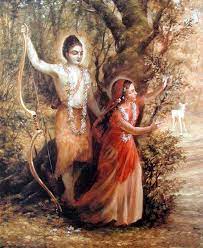 Lord Rāma and Sītā-devī, source: houseofbhakti.com, access date: Nov.03, 2022.
Lord Rāma and Sītā-devī, source: houseofbhakti.com, access date: Nov.03, 2022.
The weddings are celebrated at Mithilā with great festivity, and the wedding party returns to Ayodhyā. On the way, Rāma meets and faces down the fierce warrior-brahman, Rāma Jāmadagnya (Paraśurāma), the legendary nemesis of the warrior class who, like Rāma himself, is regarded as an avatāra of Lord Viṣṇu. At last, the brothers and their brides settle in Ayodhyā, where they live in peace and contentment. The kāṇḍa thus serves as a sort of bildungsroman of the epic hero, outlining his education into traditional lore, his initiation into the secrets of supernatural weaponry, his boyhood feats, and his marriage.
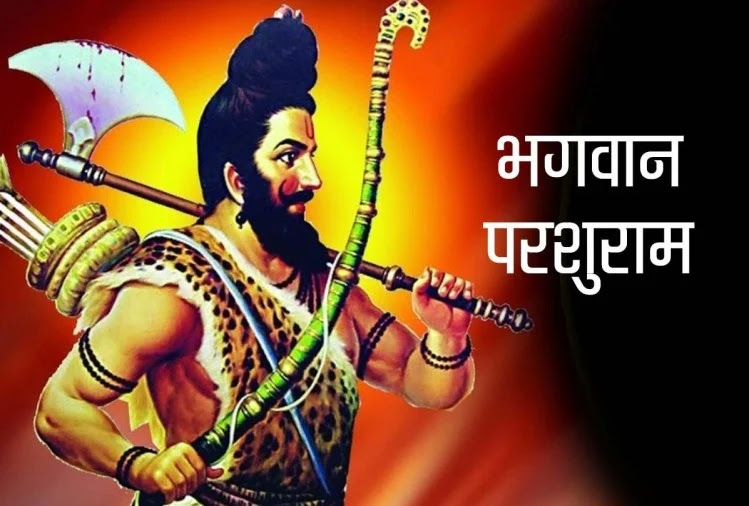 Rāma Jāmadagnya (Paraśurāma), source: www.theflain.com, access Date: Feb.4, 2023.
Rāma Jāmadagnya (Paraśurāma), source: www.theflain.com, access Date: Feb.4, 2023.
References:
01. from. "The Illustrated Ramayana: The Timeless Epic of Duty, Love, and Redemption," ISBN: 978-0-2414-7376-4, Penguin Random House, 2017, Printed and bound in China, www.dk.com.
02. from. "The Rāmāyaṇa of Vālmīki - THE COMPLETE ENGLISH TRANSLATION," Translated by Robert P. Goldman, Sally J. Sutherland Goldman, Rosalind Lefeber, Sheldon I. Pollock, and Barend A. van Nooten, Revised and Edited by Robert P. Goldman and Sally J. Sutherland Goldman, ISBN 978-0-6912-0686-8, 2021, Princeton University Press, Printed in the United States of America.










